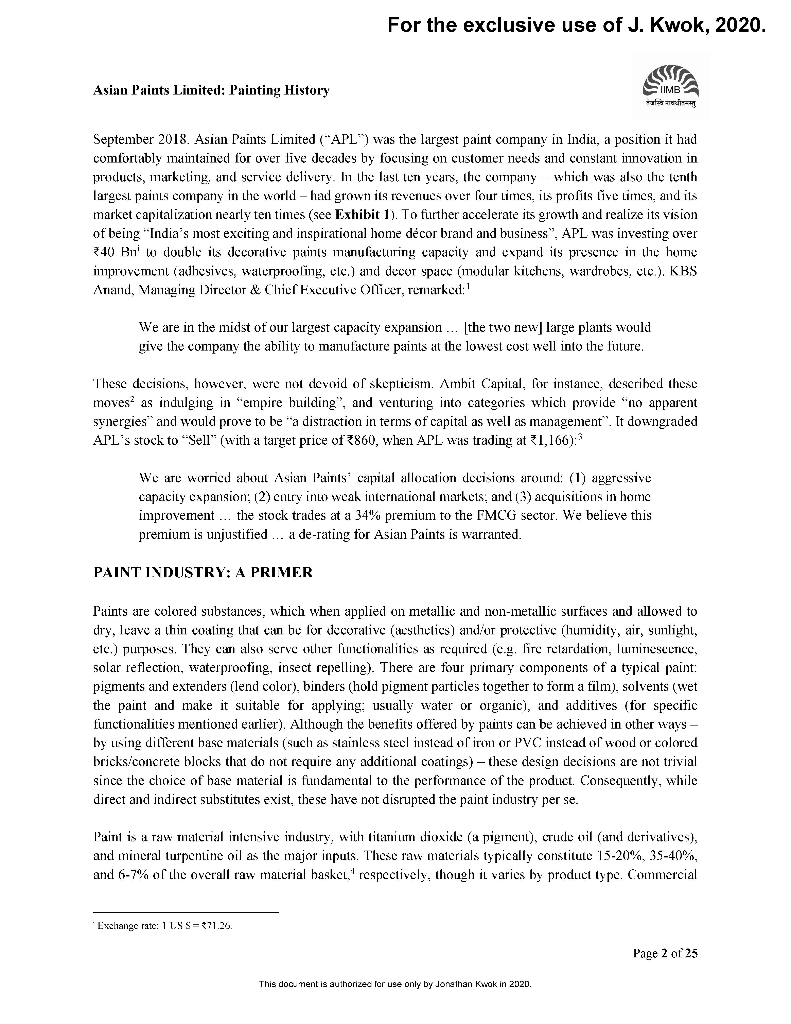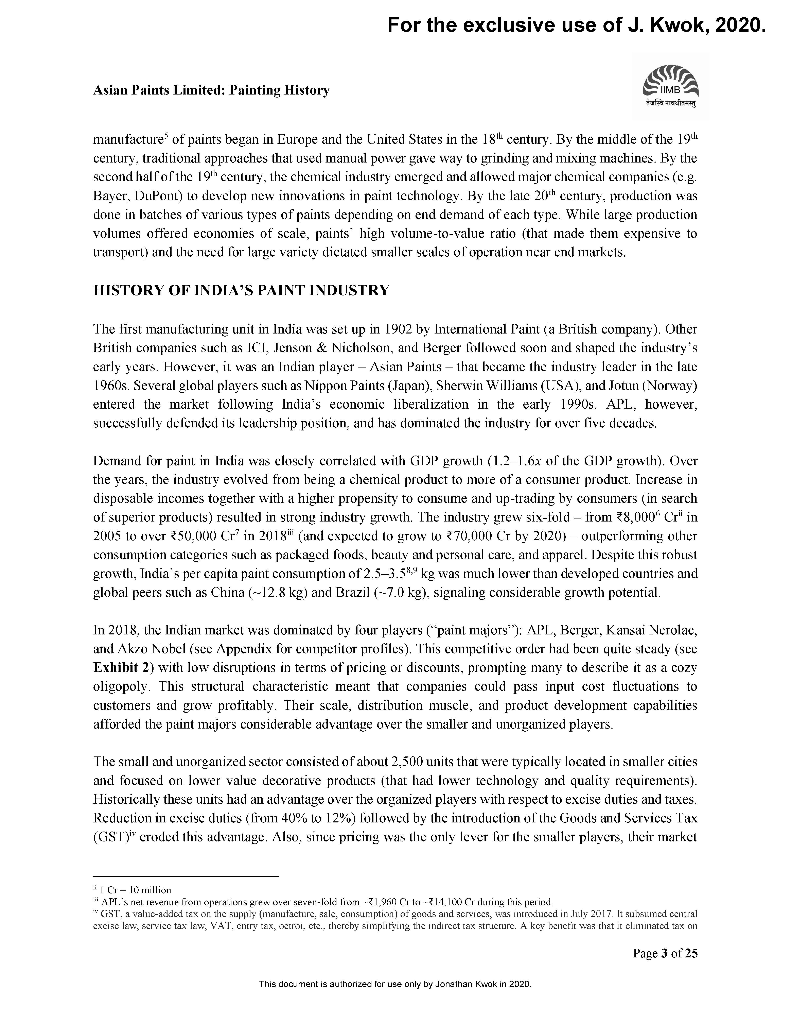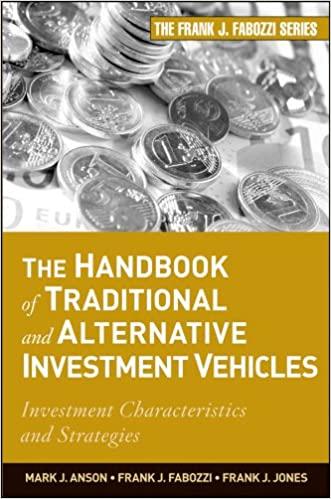What are Asian Paints Limiteds success drivers?
-Use the Key Success Factors (KSF) concept to describe it in detail.500words



For the exclusive use of J. Kwok, 2020. Asian Paints Limited: Painting History SIMBA September 2018. Asian Paints Limited ("APL) was the largest paint company in India, a position it had comfortably maintained for over live decades by focusing on customer needs and constant innovation in products, marketing, and service delivery. In the last ten years, the company which was also the linth largest paints company in the world - had grown its revenues over four times, ils profits live times, and its market capitalization nearly ten times (see Exhibit 1). To further accelerate its growth and realize its vision of being 'India's most exciting and inspirational home decor brand and business". APL was investing over 340 But w double ils Accorative painly innufacturing capacily and expand its presence in the home improvement (adhesives, waliprooling, clc.) and decor space (modular kitchens, wardrobes, clc.). KBS Anand, Managing Director & Chief Executive Oficer, remarked' We are in the midst of our largest capacity expansion ... [the two new] large plants would give the company the ability to manufacture paints at the lowest cost well into the future, These decisions, however, were not devoid of skepticism. Ambit Capital, for instance, described these moves as indulging in "empire building", and venturing into categories which provide "no apparent synergies and would prove to be "a distraction in terms of capital as well as management". It downgraded AIL's stock to "Sell" (with a target price of 7860, when ALL was trading at 21,166): We are worried about Asian Paints capital allocation decisions around: (1) aggressive capacity expansion; (2) entry into weak international markets, and (3) acquisitions in home improvement ... the stock trades at a 34% premium to the FMCG sector. We believe this premium is unjustified ... a de-rating for Asian Paints is warranted. PAINT INDUSTRY: A PRIMER Paints are colored substances, which when applied on metallic and non-metallic surfaces and allowed to dry, Icave a thin coaliny lit can be for decorative (itesthetics) and or proleclivc (lumidity, air, sunlight, etc.) Putukses, They can also serve eller lumctionalities as requircd (cy, lire relardation, luminesceTICC, solar reflection, waterproofing, insect repelling). There are four primary components of a typical paint: pigments and extenders (lend color). binders (hold pigment particles together to form a film), solvents (wet the paint and make it suitable for applying: usually water or organic), and additives (for specific functionalities mentioned earlier). Although the benefits offered by paints can be achieved in other way's - by lusing different base materials (such as stainless steel instead of iron or PVC instead of wood or colored bricks concrete blocks that do not require any additional coatings) - these design decisions are not trivial since the choice of base material is fundamental to the performance of the product. Consequently, while direct and indirect substitutes exist, these have not disrupted the paint industry per se. Paint is a raw material intensive industry, with titanium dioxide (a pigment), crude oil (satu derivatives), and nineral turpentine oil as the major inputs. These raw materials typically constitute 15-20%, 35-40% and 6-7% of the overall raw material haskel,' respectively, though il varies by product type. Conmercial Exchange rate: 1 USS=*71.29. Page 2 of 25 This doc. nent is authorized for use only by Jonathan Kwok in 2020. For the exclusive use of J. Kwok, 2020. Asian Paints Limited: Painting History SIMB manufacture of paints began in Europe and the Cnited States in the 184 century. By the middle of the 194 century, traditional approaches that used manual power gave way to yinding and inixing machines. By the second half of the 19 century, the chemical industry emerged and allowed major chemical companics(c.g. Bayer, DuPont) to develop new innovations in paint technology. By the late 20th century, production was done in latches of various types of paints depending on end demand of each type. While large production volumes offered economies of scale, paints high volume-to-value ratio (that made them expensive to transport) and the need for large varicly dielaled smaller scales ol' operation 1car end 111rkels TIISTORY OF INDIA'S PAINT INDUSTRY The lirst manufacturing unit in India was set up in 1902 by International Paint (a British company). Other British companies such as ICI, Jenson & Nicholson, and Berger followed soon and shaped the industry's carly years. However, it was an Indian player - Asian Paints - that became the industry leader in the late 1960s. Several global players such as Nippon Paints (Japan). Sherwin Williams (USA), and Jotun (Norway) entered the market following India's economic liberalization in the early 1990s. APL, however, successfully defended ils leadership position, and has doninalcd the industry for over live decades. Demand for paiul in Inclia was closely correlated with GDP growth (1.2 1.6x of the GDP growth). Over the years, the industry evolved from being a chetnical product to more of a consumer product. Increase in disposable incomes together with a higher propensity to consume and up-trading by consumers (in search of superior products) resulted in strong industry growth. The indlustry grew six-fold - from 8,000" Cr" in 2005 10 over 50.000 Cr? in 2018" (and expected to grow 1 70,000 ( by 2020) Oulperforming other consumption calcgories such as packaged foods, beauty and personal care, and apparel. Despite this robust growth, India's per capita paint consumption of 2.5-3.58.9 kg was much lower than developed countries and global peers such as China (-12.8 kg) and Brazil (--7.0 kg), signaling considerable growth potential. In 2018, the Indian market was dominated by four players (painl majors'): APL, Berger, Kansai Nerolac, und Akzo Nobel (sce Appendix for cutitor profiles), This competitive ordet had been quite steady (SCC Exhibit 2) with low disruptions in terms of pricing or discounts, prompting many to describe it as a cozy oligopoly. This structural characteristic meant that companies could pass input cost fluctuations to customers and grow profitably. Their scale, distribution muscle, and product development capabilities afforded the paint majors considerable advantage over the smaller and unorganized players. The small and unorganized sector consisted of about 2.500 units that were typically located in smaller cities and focused on lower value decorative products that had lower technology and quality requirements). Historically these units had an advantage over the organized players with respect to excise duties and taxes. Reduction in exciye duties (from 40% l 12%) followed by the introduction of the Goods and Services Tax (GST)* cruded this advantage. Also, since pricing was the only lever for the smaller players, their market i -lo million ATT's nel revenur from operangre el sexer-lold lion: 31950 a 314,100 C uring this perind **GST. a value-addal tax or the supply (manufacture, sale, consumption of goods and services, was introduced in July 2017. It subsumed central excisc law, service tax law, VAT.chery tax, troicte.. thereby simplit 118 the indirect tax structure. A key benctie was that. ch atod tax on Page 3 of 25 This doc. nent is authorized for use only by Jonathan Kwok in 2020. For the exclusive use of J. Kwok, 2020. Asian Paints Limited: Painting History SIMB share steadily declined from 45% to 35% over the last decade. Unlike some FMCG products (eg, biscuits, detergents), outsourcing in paints was limited to lower-end products. The top four players purchased about 30% of their lolal sales volumes, with the rest memulactured in-house, PRODUCT SEGMENTS Paints can be classified into two primary product segments: Decorative/Architectural paints and Industrial paints (sec Exhibit 3). A1 70-75% share,ll of the overall Indian paints maket in valuc terms, the decorative segment was significantly larger than the industrial segment. Internationally, though the industrial segment was typically larger in developed economies, with the global average being 58%. The decorative segnient comprised exterior and interior wall paints (emulsions, cnanels, distempers), primers, varnishes, pulties, cle. Their demand stemmed from residential (35-40% repainting. 20-25% new houses), commercial offices, malls, about 25%) and industrial/institutional (about 15%) users, and saw significantly higher demand during the festive season (September to December). Distribution in the decorative segment was direct lo rclail; thTC WTC no wholesale distributors who broke bulk or helped m ac credit to relailers. Hence, pain companies needed to directly deal with thesauds of retailers and manage credit with them on average, the industry gave credit of three weeks to retailers). Over the years, all the paint majors had invested heavily in expanding their distribution network (see Exhibit 4), particularly in rural India. They had also installed Computerized Color Dispensers ("CCDs") or lining machines al a large number of their calerships. These CCDs could produce large variety of shades using a small set of standard colors, thereby minimizing inventory requirements at points of sale. Though CCDs were pioneered in India by Tenson & Nicholson, all paint majors adopted them. CCDs were manufacturer-specific and required significant space (2535 sq. ft.), making it very difficult for a new company to penetrate existing outlets. CCDs liad a payback period of three to five years, and typically paint companies helped their dealery linance the initial outlay of 3-4 lakhs per CCD. While buying continued to be heavily influenced by painters, contractors and dealers, involvement of end consumers in the purchase decision was gradually increasing. Paint consumers were becoming less price- sensitive and were willing to pay a premium for better products and brands. The industry therefore witnessed a huge growth in premium products since the late 2000s. This trend was homogeneous across India, including in small cities. Creative marketing campaigns and sustained endorsements by celebrities evolved this hitherto low involvement consumer category into an aspirational brand play and created strong brands for the paint majors, a facet that was challenging for new and smaller players to replicate. That said, the brand spend of these paint companies was generally lower than that of FMCG players. Both these aspects histribution and trand enabled the top lour players to command considerable pricing power. They were able to pass through cost inllation to consumers at times of high inflation, with API laxie lexible lacation, which casc ulei liom the manucur ng level to the consumption level TI wis the largely relium in the country since independencc and was cxpcaied to integrate the economics of the various sates in the nation and ad economic growth. 10 lakhs = 1 million Page 4 of 25 This doc. nent is authorized for use only by Jonathan Kwok in 2020









